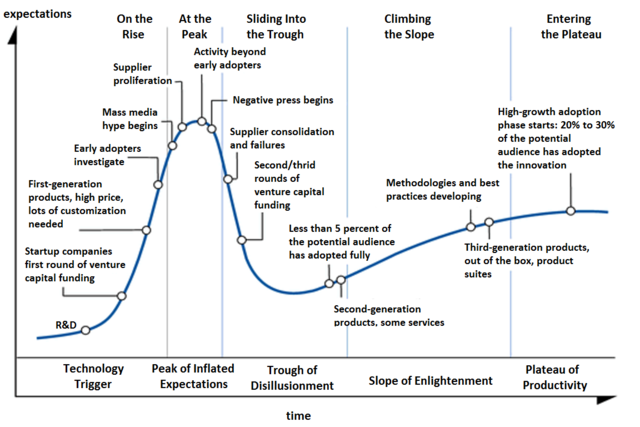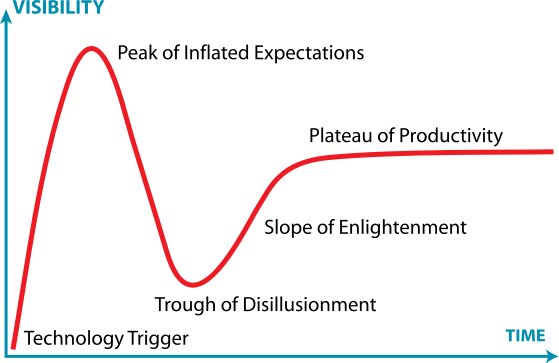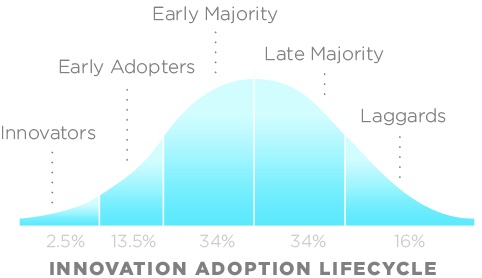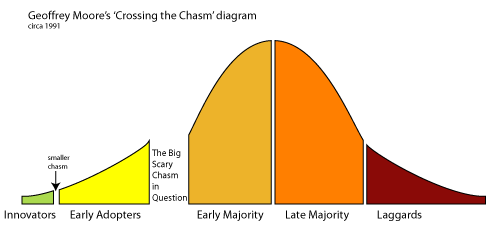Seven sins and the Hype Cycle
Where does the Hype Cycle come from?
Okay, we know it was originated by consultancy-firm Gartner some years ago, and that it looks like this:
Or, more simply, like this:
And we also know that it aligns well with Rogers et al’s technology-adoption lifecycle:
And the way that the Hype-Cycle’s ‘Trough of Disillusion’ aligns with the gap between the adoption-lifecycle’s Early Adopters and Early Majority is a key part of what creates ‘the chasm’, as per Geoffrey Moore’s Crossing the Chasm:
All of which is fair enough, and well documented and all that.
But why does the Hype-Cycle exist? What causes it? What drives it?
Or, perhaps more to the point – given the amount of wasted-effort and worse that it would usually cause – what, if anything, could we do to mitigate against it?
Seems to me that the key clue is right there in the name itself – Hype-Cycle. That sequence of events and failures isn’t inevitable: instead, the Hype-Cycle is literally held together by hype.
But if we go back to those posts on ‘The seven sins of dubious discipline‘, then hype itself is at the core of just one of those ‘sins’ of scrambled-sensemaking – specifically, of the Hype Hubris. In which case, what about the other ‘sins’? – might those too have impacts on the Hype-Cycle?
Hmm… – might be something worth exploring, methinks? So here goes:
— Sin #1: The Hype Hubris – Hype is right at the core of the Hype-Cycle, and the key cause of over-inflated expectations.
— Sin #2: The Golden-Age Game – Technophilia is a key emotional driver behind technology-oriented hype, and is itself driven largely by Golden-Age style cravings for an imagined ‘perfect future’.
— Sin #3: The Newage Nuisance – An excess of hype enables selective-ignorance, exaggeration, playing ‘fast and loose’ with facts or data, and all of the other ‘why-bother-with-discipline?’ characteristics of the Newage Nuisance.
— Sin #4: The Meaning Mistake – Emotional exuberance from the Hype Hubris, the Golden-Age Game and the Newage Nuisance make it easy to miss hidden-assumptions and suchlike that can make the development go half-baked, over-cooked or both.
— Sin #5: The Possession Problem – Proprietary information makes fact-checking much harder, making the Meaning Mistake more likely; and delusions of ‘This Is The Truth’, or ‘This Changes Everything’, in turn feed the Hype Hubris, the Golden-Age Game and even the Reality Risk.
— Sin #6: The Reality Risk – A tunnel-vision over-emphasis on expected gains, and a cavalier attitude to risks from unintended-consequences, creates a dangerous disconnect from reality, or even any kind of reality-check.
— Sin #7: Lost In The Learning Labyrinth – The emotional and other challenges of working with the new and unknown are often glossed-over; and people routinely mistake the very first stage, Beginner’s Luck, as having already arrived at completion, although in reality there’s a very long way still to go…
In short, the exaggerated upward-slope towards the Peak of Inflated Expectations is pretty much a direct outcome of the impact of any or all of the ‘seven sins’; and the crash downward towards the Trough of Disillusionment occurs when the mythquakes from the failures of the ‘seven sins’ eventually become impossible to ignore. Failure to rein in the ‘seven sins’ is a key cause of that disconnect from reality – both the over-inflation of expectations, and the subsequent excessive doubt.
All of which kinda suggests a rather important question – that if the ‘normal’ Hype-Cycle curve looks like this:
…then what would the Hype-Cycle look like if we, well, took out all of the hype and the rest of the ‘seven sins’?
The short-answer seems to be that it would look something like this:
Without the hype, there’d be no rise to a Peak of Inflated Expectations, because no-one would be inflating the expectations.
There’d be no Trough of Disillusionment, either, because the expectations wouldn’t have been inflated in the first place.
And because there’s no Trough of Disillusionment, there’d also be no ‘chasm’ between Early Adopters and Early Majority.
Instead, all we’d have is a quiet, calm, steady, unhyped slog:
- a whole stream of initial experiments by the Innovators
- tests in practice by the Early Adopters
- proven ready for take-up by the Early Majority
- eventually rounded-off at the Plateau of Productivity for the more risk-averse Late Majority and Laggards
In short, the rise and fall of the early part of the Hype Cycle is almost entirely an artefact of inadequate sensemaking-discipline.
Without the hype, it looks kinda boring, perhaps, but it works. Slogging along out in the backroom, innovating it, testing it, making sure it does work, all with the minimum of fuss.
In my own work, it’s why I put so much effort into keeping the sensemaking-failures at bay. There’s a lot of effort, a long un-hyped slog – but at the end of it, it just works.
The catch is that if it ‘just works’, people out in the Early Majority and beyond kinda think “it’s obvious!“, that it just happened on its own, without anyone needing to make it happen. Which, actually, wasn’t the case at all: there was a heck of a lot of, yes, un-hyped slog – and on my part most of it a long unpaid slog, too, around which, yes, I do occasionally wail that “I just can’t afford it any more“. Which is kinda awkward: seems like it’s really hard these days to ‘make a living’ by doing good work that actually works, yet without all of the hype.
Or, to put it the other way round, it kinda seems like these days ‘making a living’ all but depends on creating hype, on creating Golden-Age delusions, on indulging in all of the ‘seven sins’ as much as we possibly can. Which is exactly what creates the dysfunctions and wastefulness of the Hype Cycle in the first place. Oops…
Which kinda suggests there’s a lot of social-pressure coming from somewhere to get people to make those mistakes – much like the social-pressures towards technophilia and suchlike, such as we explored in the previous ‘Luddite, and proud‘ post.
So where do those social-pressures come from? Who’s promoting conditions under which sensemaking-mistakes of the ‘sins’ are more likely to happen? – or at least, dissuading people from taking action to prevent those mistakes from happening? Who benefits from such failures? – whilst causing serious damage and disruption for everyone else? Who’s raking in the money from making so much mess?
Yeah, interesting questions, aren’t they…?





“Nobody Ever Gets Credit for Fixing Problems that Never Happened”.
The Hype cycle is a perfect example – first say there’s a problem (overinflated expectations), then call us in to “solve” it (slope of enlightenment).
Depressingly accurate, Pallab. Sounds like a topic for yet another blog, methinks…
Does the difference between two graphs correspond vendor-driven-market vs customer-driven-market behaviour?
Thanks,
AS
Very good point, Alexander.
My answer would be “not quite” – or rather, it depends what you mean by ‘customer-driven market’.
The classic Hype-Cycle, yes, it’s an all-too-obvious vendor-driven pattern – otherwise known as ‘inside-out’ marketing, or ‘push-marketing’, “we have something to sell, how can we hype it enough to, uh, trick you into buying it?”.
The Un-Hype Cycle is not so much customer-driven as needs-driven. It’s ‘outside-in’ marketing, or ‘pull-marketing’, though not necessarily driven by the customers themselves, but more from a developed awareness of what’s needed within the context. (In terms of the enterprise-context map I’ve been using in my various blog-posts, it’s the difference between ‘the market’ and the much broader ‘shared-enterprise’, a broader purpose-story rather than just a transactional-story.)
The point is that, at the start, the customer often doesn’t know their real needs – the classic attributed-to-Ford about “if I’d asked my customers what they’d wanted, they’d have asked for a faster horse”.
I suspect that, for a literal ‘customer-driven market-behaviour’, there’s actually a second somewhat-milder hype-pattern – illustrated in the Gartner Hype-Cycle by the overshoot and correction at the top of the Slope of Enlightenment (for the Early Majority group), before it settles back down to somewhat lower Plateau of Productivity (for Late Majority) and gentle decline (for the Laggards). But that’s something to explore in another post, I guess.
IT can be a source of hype as well. Last year’s microservice “bubble” is a good example of people latching on to something they “just have to have”, not necessarily in response to a particular need, but due to one or more “big names” expressing interest in it.
Yes, Gene, agreed – all too true.
(I’ll be exploring the impact of “certain ‘big names’ expressing interest in [whatever]’, in the next couple of posts. Will be interesting to see what the response is. :wry-grin: )